For the last six months, we’ve been in an awkward spot where we had one Phyrexian: Kaldheim’s Vorinclex, Monstrous Raider. With the release of Modern Horizons 2, Wizards of the Coast has fully rolled out the Phyrexian creature type. We weren’t sure until now to which cards this new creature type would apply—whether, that is, it would be the rank and file (including Rank and File) Phyrexian troops, or would just be for Praetors and Phyrexian Dreadnoughts.
We now have our answer, and are welcoming two hundred and twenty six Phyrexians to add to the roster along with Vorinclex. Most are expected, but there are a few surprises. I didn’t expect Rackling, Viseling, or Selenia, Dark Angel to make the cut.
There’s no real tribal synergy to Phyrexians—yet—but it feels as though we’re building up to a return to New Phyrexia after a decade with only the occasional Legend to whet our appetite for an eventual return. It’s not exactly calling a tough shot to draw this connection after we got a Praetor in Kaldheim, but more confirmation is always welcome, and that’s precisely what I’m reading the Phyrexian revolution as. Personally, I’m very excited—Phyrexia has always been my favorite Magical plane, and New Phyrexia is one of my all-time favorite sets.
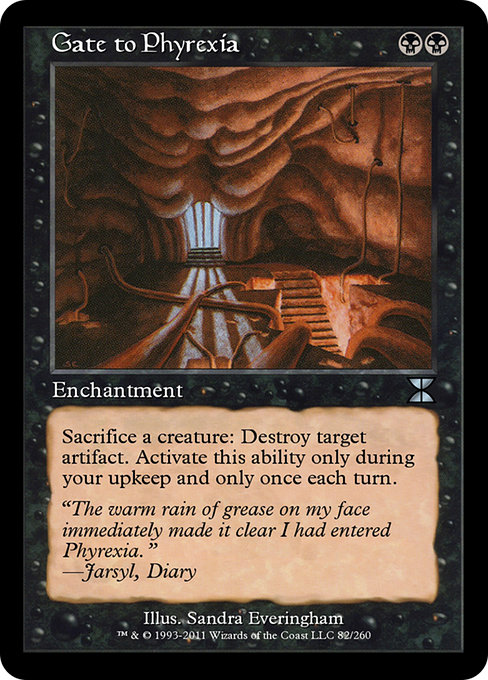
Phyrexians date back almost to Magic’s inception and arrived on the scene fully-formed in 1994’s Antiquities. The set chronicled the war between Urza and Mishra and introduced players to the dark domain that would seduce and transform Mishra (and would shape Magic’s story for the next decade): Phyrexia. Wizards nailed Phyrexia immediately in Antiquities as a hellish landscape of tormented souls and living metal.
Mechanically, Phyrexians fed on artifacts (Priest of Yawgmoth, Gate to Phyrexia) and warped artifacts to their needs (Phyrexian Gremlins). Yawgmoth Demon was somewhat confusing, as the lack of a Legendary supertype at the time meant players confused this demon with the antagonist, but it cemented Phyrexia’s ethos as an ever-churning sacrificial spiral, where the weak are torn to pieces and rebuilt into the strong.
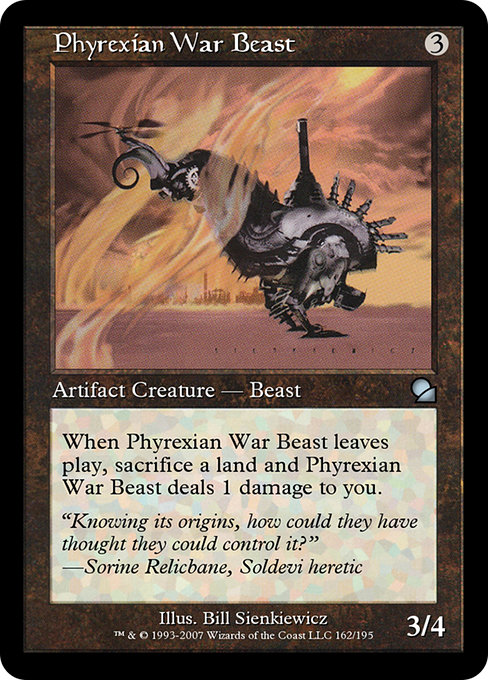
Following Antiquities, Phyrexia never fully went away, but was a background plane in 1995-1997. We saw the occasional Phyrexian Dreadnought or Phyrexian War Beast, but those were the remnants of the plane’s influence during the Brothers’ War and the results of Arcum Dagsson’s archeological digs—relics rather than current influence.
Rath was a satellite plane of Phyrexia, but we didn’t know that when Tempest launched. And if you weren’t paying attention to the comics and books, you could have missed that entirely. Not so in Urza’s block, all black cards from Urza’s Saga and Urza’s Destiny came from Phyrexia. (The black Urza’s Legacy cards were Phyrexian agents stranded in Dominaria.) This was where Phyrexia truly expanded on its initial concept to become a perverse mirror of a natural ecosystem, one with Witch Engines and religious scriptures and Flesh Reavers and “birthing vats”—basically, all the stuff to fire up the imagination of young nerds who liked body horror and splatterpunk.
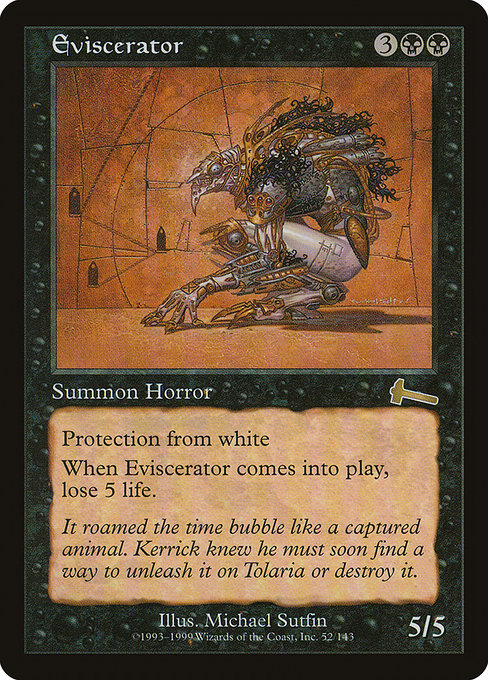
Phyrexia may be a hell to Dominarians, but it was always a heaven for kids like me. I was a horror kid—watching Hellraiser between the gaps in my fingers, getting introduced to the American canon through Bruce Coville’s age-appropriate anthologies, scouring action figure magazines and video catalogs for the most grotesque creature designs to spook myself with. Phyrexia was the gnarly pinnacle of Magic’s art design for me—Spined Fluke, Eviscerator, Reclusive Wight—were all clearly organic creatures that had been warped and tortured until they became alien predators.
This is part of why I pushed back against Invasion block when it came out. While it pulled the game out of the doldrums of Masques block and revived multicolored decks, Phyrexians became more about nanotechnology and cyborgs than the Phyrexia I fell in love with. We had armies of spiky warrior drones and spinal implants instead of Phyrexian Negators and Eviscerators, clouds of battleflies and viral nanobots instead of Skirges and necromancy. It became sci-fi body horror instead of fantasy body horror.
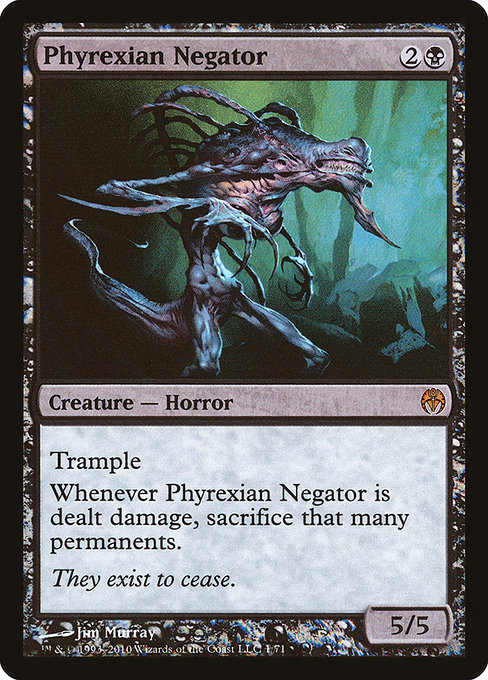
While artifacts and heightened technology had always been a part of Phyrexia since 1994, the Invasion era Phyrexia was about the fear of a global pandemic or military invasion rather than the fear of predation and victimization. There was a lot of ambient anxiety about an uncertain future back in 1999-2000 and the millennial crossover. We knew society was changing, but we weren’t sure whether it was a healthy adaptation or a dead-end mutation. Phyrexia’s evolution from artifact hell to necrorobot army was, in some way, influenced by the generalized neuroses of the era.
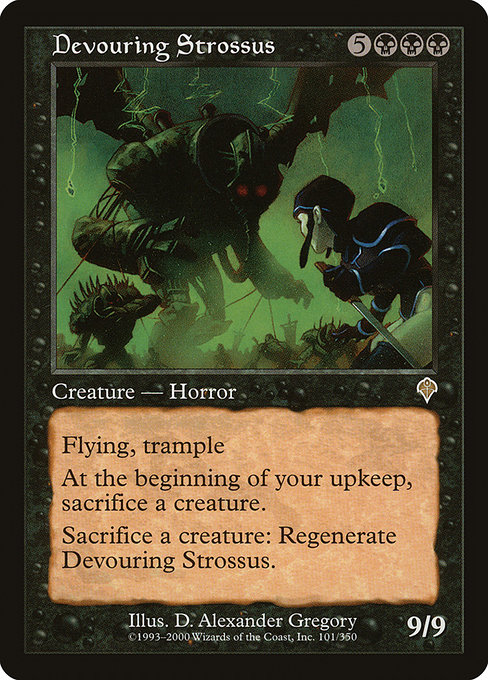
It’s not the only time Magic has changed to reflect societal standards. Magic’s initial popularity brought with it a minor controversy; fresh off the Satanic Panic and the artistic censorship movement of the ’80’s and ’90’s, which gave us “explicit content” labels and endless pearl-clutching encyclicals from editorial boards, Magic’s demonic imagery was a target of parental rage. Wizards reacted by scrubbing pentagrams from Magic art and replacing the “Demon” creature type with “Horror.” Horrors kept the same “deal with the devil” flavor as Demons (see Eviscerator or Devouring Strossus) but without the Christian baggage.
Personally, I find Gallowbraid much more disturbing than a horned red beefcake, but the culture was different twenty-five years ago. Demons returned to Magic with much fanfare in Onslaught block, where Juzam Djinn variant Grinning Demon and Mutilate variant Havoc Demon failed to live up to the hype, but also failed to warp young minds and damn young souls. Ironically, the removal of “Demon” from the game in favor of the “Horror” creature type truly gave old Phyrexia its identity.
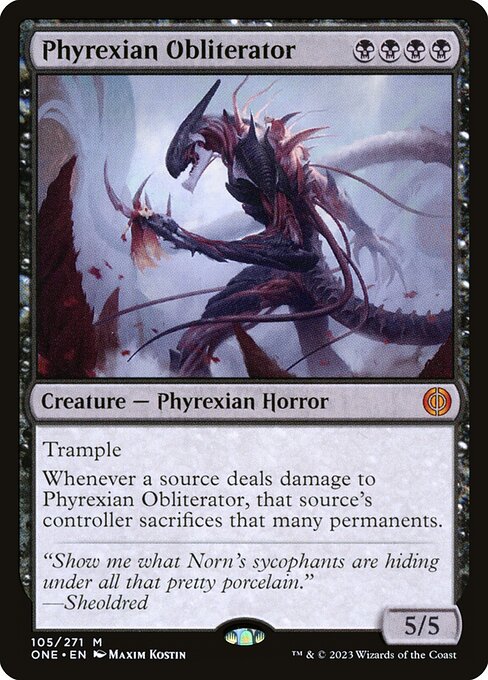
Without demons, this wasn’t an analogue for a religious Hell, but a functioning biome of alien horrors. In a Phyrexian twist, Wizards adapted to social requirements by changing Demons to something much more disturbing—demons are scary enough, but a “Negator” is terrifying in its implacable, open-ended destruction. The Phyrexianization of creatures is different from the Demon pseudoscandal, of course. It’s an updating, rather than a revival, and it doesn’t come with the cultural baggage of the demon/devil archetype as it sticks to an independent property controlled by Wizards—but it has a similar resonance in the game.
The addition of Phyrexian to Magic’s creature types also has a mechanical impact, of course. Infect has a new answer:Glistener Elf, Inkmoth Nexus, and Blighted Agent are now extremely susceptible to a traitorous Plague Engineer set to “Phyrexian.” On the plus side, new-to-Modern Patriarch’s Bidding can now bring back all the Praetors at once. The usual tribal cards, like Cover of Darkness and Herald’s Horn, are now options in Phyrexian decks; but the tribe doesn’t have a cohesive mechanical identity, other than a vague “making creatures smaller by making them sicker” through Infect and Carriers. I’m fine with that, as the Devoid Eldrazi just detracted from the coolness of Eldrazi, and Phyrexians as a motley grab bag of horrors and griefers is conceptually on-brand.
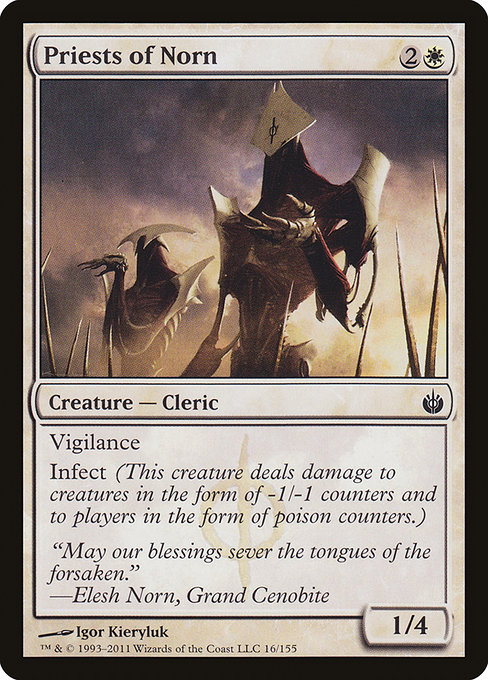
If anything, Wizards missed out on an opportunity to let the Phyrexian creature type override all other identities, reducing each Phyrexian creature solely to “Phyrexian,” instead of, say “Phyrexian Cleric.” Phyrexia subsumes all identity for the greater good; you are no longer a self-actualizing creature, but only defined by how useful you can be to Phyrexia itself. For example, it’s strange that Blind Zealot is now a “Phyrexian Human Cleric,” when the process of Phyrexian compleation seems to erase all humanity. Compare it to Priests of Norn, who are so far removed from their former (presumed) humanity, that they defined solely by their role in the hive mind of Phyrexia.
I’ve been accused of over-abstracting Magic’s appeal, and the compleation of these two hundred odd creatures has reminded me to stick to the basics: this change is incredibly cool. Phyrexian Crusader, for example, is now a “Phyrexian Zombie Knight,” which is basically the raddest thing you can be, occupationally-speaking; Wurmcoil Engine also gets an added frisson of darkness. Legends who served Yawgmoth—Tsabo Tavoc, Greven il-Vec, Belbe, Volrath—are all finally Phyrexians, and cards who were obviously shock troops in the Mirran-Phyrexian War have ascended.
If we’re truly setting up a return to New Phyrexia, this is a beautiful way to handle it: with the addition of the Phyrexian creature type, Magic becomes a little more compleat, a bit more dangerous.
A lifelong resident of the Carolinas and a graduate of the University of North Carolina, Rob has played Magic since he picked a Darkling Stalker up off the soccer field at summer camp. He works for nonprofits as an educational strategies developer and, in his off-hours, enjoys writing fiction, playing games, and exploring new beers.



